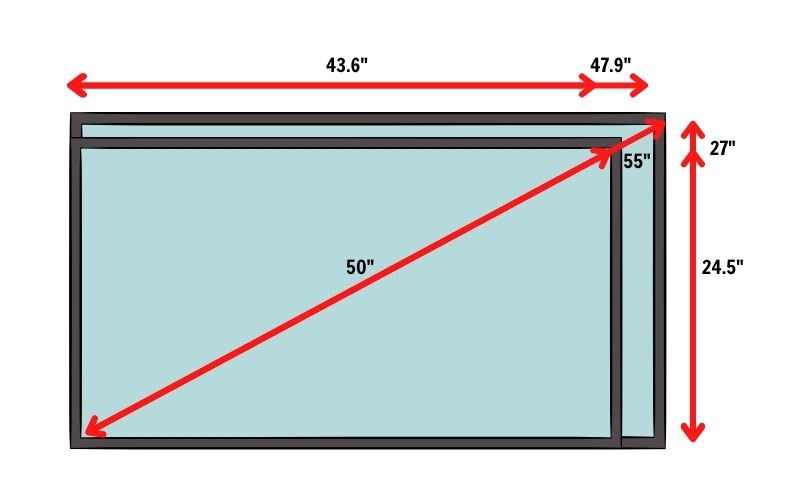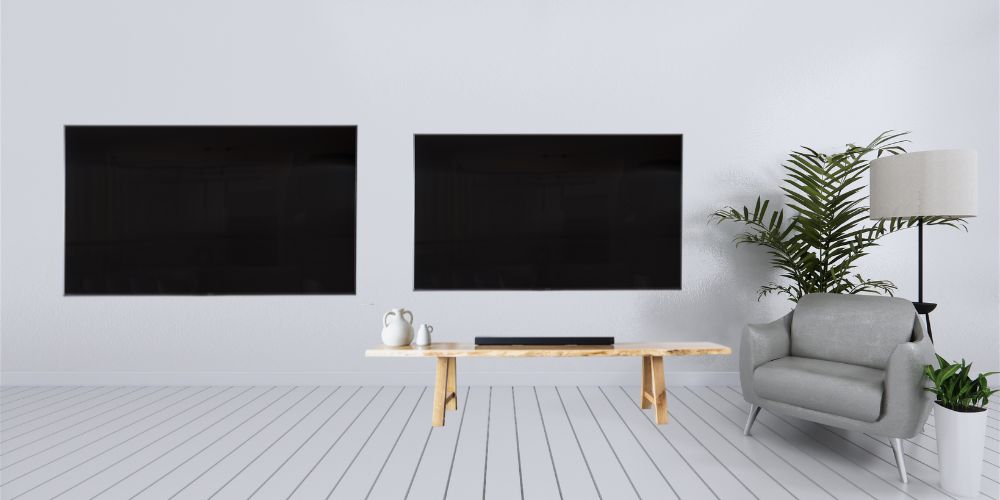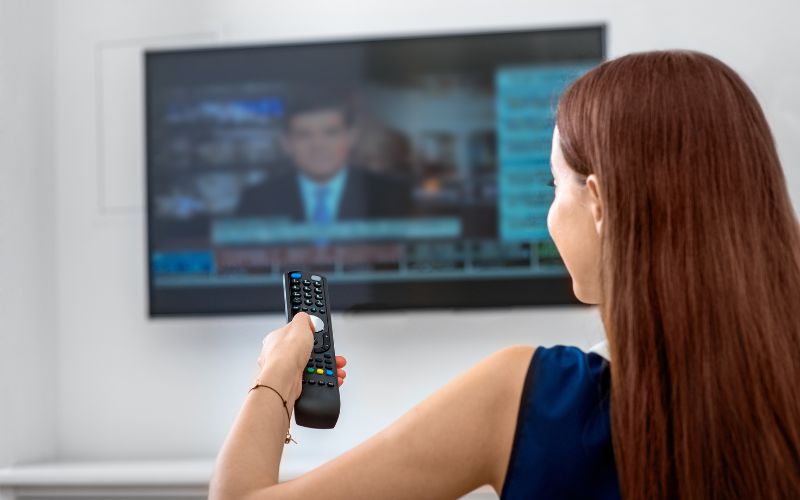If you’re trying to buy a new TV, finding one that’s the right size for you can be a little tricky. Especially when there are so many that are similar – how do you know if a 50-inch or a 55-inch TV is the best option for you?
Don’t worry, because with this guide I’m going to make it easy for you. I’ll break down the key differences between these two screen sizes, both in terms of dimensions and availability.
By the end, you’ll have a much clearer idea of which screen size is the one you want to go for.

Is there a big difference between 50-inch and 55-inch TV?
In terms of size, there isn’t a huge difference between a 50-inch and a 55-inch TV. The 55-inch TV is only a few inches wider and a couple of inches taller. But 55-inch has become the standard for mid-sized TVs, so there is more choice available.
There’s a huge range of different TV sizes available, and over time we’re seeing some more popular screen sizes start to fade slightly. 50-inch TVs are one of those.
There are still some great 50-inch TVs being made, but a lot of manufacturers are skipping this screen size for the best models, opting instead to jump from 43-inches to 55-inches.
There are a few reasons for this, but the main ones come down to manufacturing processes and popularity. When it comes to manufacturing, it’s all about how cost-effective it is to buy the screens, and as the processes change there are certain screen sizes that are more effective because you can stamp more of them out of the same sized piece of glass.
And then when it comes to popularity, 55-inches just sounds better than 50-inches – it sounds like a significant difference even if it isn’t in real terms.
So if you could make a 50-inch TV or a 55-inch TV for roughly the same cost, but the 55-inch sounded more appealing to your customers, you would prioritise the larger size.
50-inch And 55-inch TV Dimensions
Here are the dimensions of a 50-inch and a 55-inch TV:
| TV size | Corner to corner | Height | Width | Area |
|---|---|---|---|---|
| 50-inch | 50 inches | 24.5 inches | 43.6 inches | 1,068.2 square inches |
| 55-inch | 55 inches | 27 inches | 47.9 inches | 1,293.3 square inches |
| Difference | 5 inches | 2.5 inches | 4.3 inches | 225.1 square inches |
You can see the difference a little more clearly in this diagram. A 55-inch TV is only an extra 2.5 inches tall and 4.3 inches wide, but that combined difference is what gives you the upgrade to a screen that’s 55 inches from corner to corner, with an extra 225 or so square inches of viewing space.

How much bigger is a 55-inch TV than a 50-inch?
A 55-inch TV is 2.5 inches taller and 4.3 inches wider than a 50-inch TV, which gives you an additional 225.1 square inches of screen, the same as 1.6 square feet. The difference isn’t massive, but it’s definitely noticeable when you go from one to the other.
Strangely, because the screens aren’t massively different, if you upgrade to either from say a 40-inch TV you’ll probably find them equally impressive. But, you will feel like you’ve got an upgrade if you replace a 50-inch TV with a 55-inch one, even though it’s not drastically larger.
50 Vs 55 Inch TVs Side By Side
The photo below shows what a 50-inch TV looks like side by side with a 55-inch TV…

Side by side, you will clearly see the difference between a 50-inch and a 55-inch TV, since the 55-inch TV is taller and wider.
What also has an impact is the size of the bezel. The dimensions given are purely for the screen, but the surrounding bezel can sometimes add a couple of inches.
So depending on the TV models, a 50-inch and a 55-inch TV could take up almost the same physical space, if the 55-inch TV has a super-thin bezel while the 50-inch one has a thicker one. That’s not too unlikely either, as 55-inch TVs tend to be more premium and so are more likely to have an edge-to-edge screen.
Should you get a 50-inch or 55-inch TV?
If you have the budget available, then it’s best to shop in the 55-inch range. The extra screen size is useful, but more importantly, you’re likely to get a TV with better features too. For the best in picture and sound quality, 55-inch TVs are broadly better than 50-inch models.

LG OLED C1 Series 55” Alexa Built-in 4k Smart TV
The best 55-inch TV
This TV has a home cinema experience that makes you feel like you’re right in the action. It’s fast for gaming and has built-in access to Google Assistant, Alexa, Netflix, Prime Video, Apple TV and more.
But that’s not always the case, so here are some important notes to consider when deciding which one is right for you.
Price
One of the most important factors when choosing your new TV is going to be the price, and generally speaking, a 50-inch TV is going to be cheaper than a 55-inch one.
It’s hard to always offer a like-for-like comparison because most TV manufacturers won’t make the same model of TV available in both sizes.
But as a rough estimate, you could pay up to $100 less for a 50-inch TV compared to a 55-inch model with similar features, which is a pretty good saving.
If you’re shopping on a budget and you also want a soundbar to complete your setup, choosing the 50-inch model would probably allow you to get the soundbar included for the same price as the 55-inch TV alone.
Availability
50-inch TVs are a good choice for anyone on a budget, but there aren’t as many of them to choose from, so availability could be an issue.
The 50-inch screen size is far from dead, and there are new models still being released this year by a number of manufacturers, but often these are from budget to mid-range brands. Many Samsung, LG and Sony TVs are more widely available in the 55-inch screen size, and a lot of people prefer to buy a TV from a brand they trust.
There are still some TVs from these brands available in 50-inches, but sometimes stock can be lower for these too. If you want a TV sooner, you might find that it’s easier to pick up a 55-inch model.
Size and viewing distance
Obviously, size may play a part in your decision, based on the dimensions I’ve covered above. But because the difference in height and width is so small, most people will find that both screen sizes are a good fit for their living room.

Generally, these TVs are considered too large for a bedroom, although if you have a particularly large bedroom space then a 50-inch TV could be a good choice.
One thing to check with the size is the stand. Many TVs have a central stand, but some will have separate feet at each edge of the screen. If you’re placing your TV onto some furniture, there’s a chance that a 55-inch TV may have feet that are too far apart to fit.
The measurements aren’t standard, so you’ll need to check the individual TV and measure your furniture to see if it fits. Of course, if you’re wall mounting, this is irrelevant.
Finally, on size, it’s worth considering the optimal viewing distance. These are guidelines on the best distance to sit from a TV to properly enjoy the detail, without having to turn your neck to see everything that’s going on.
For a 50-inch TV, the optimum distance to sit from the screen is 7 feet, while it’s 7.5 to 8 feet for a 55-inch TV. It’s unlikely to make a huge difference but if you’re sat somewhere between 6 and 7 feet from the screen, a 55-inch TV might be too big.
Features
While there are exceptions to the rule, most of the time the best TV features are found on 55-inch TVs rather than 50-inch models.
Resolution isn’t a concern – you’re basically going to get a 4K TV whether you choose a 50-inch or a 55-inch. You won’t find a Full HD option at these sizes, and it’s unlikely you’ll find an 8K one either – that’s reserved for bigger screens.
But in terms of screen type, you’re usually limited to a QLED at best for a 50-inch TV, although Samsung does have one or two Neo QLED displays. Most of their Neo QLEDs are 55-inches though, as are other brands’ Mini LED screens.
If you want an OLED TV, you’re absolutely limited to 55-inches. LG does make a 48-inch OLED though if you want something a little smaller.
The latest gaming features, primarily including HDMI 2.1 ports with support for 4K gaming and up to 120 frames per second, are more commonly found on 55-inch TVs too. 50-inch TVs may have a gaming mode, but they won’t be the perfect partner for your Xbox Series X or PlayStation 5.
And because the best screen technologies are generally reserved for 55-inch TVs, from the biggest manufacturers, that’s also where you’ll normally get the best versions of LG, Samsung and Sony processors, which do an amazing job of upscaling older content to make it look incredible on the big screen.
One area where you won’t see a huge difference between the screen sizes is smart functionality. All TVs will be smart, and most 50-inch models will have the same voice control options as a 55-inch TV – they’re becoming cheap and easy to integrate, so Google Assistant and Amazon Alexa are fairly standard now.
The Best 50- To 55-Inch TV For The Money
While it might be considered quite expensive, you really won’t get a better TV for the money than this LG OLED TV.

LG OLED C1 Series 55” Alexa Built-in 4k Smart TV
The best 55-inch TV
This TV has a home cinema experience that makes you feel like you’re right in the action. It’s fast for gaming and has built-in access to Google Assistant, Alexa, Netflix, Prime Video, Apple TV and more.
OLED TVs have self-lit pixels, which means each pixel can completely shut off for amazingly deep blacks, helping the colors to really pop too. Plus, it’s packed with amazing features, like an incredible processor and Game Optimizer.
The Bottom Line
Hopefully, now that you’ve read this, your mind is a little clearer on which is the best of these screen sizes to go for. They’re both big enough that you will probably only look to use them in a living room, so it will come down to price and features.
However, you might also want to think about other factors too, including the weight of the TV, and how much electricity it uses.
If you want some more information then check out my guides on how big a 55-inch TV is, and how big a 50-inch TV is, which both go into more detail on each screen size.
